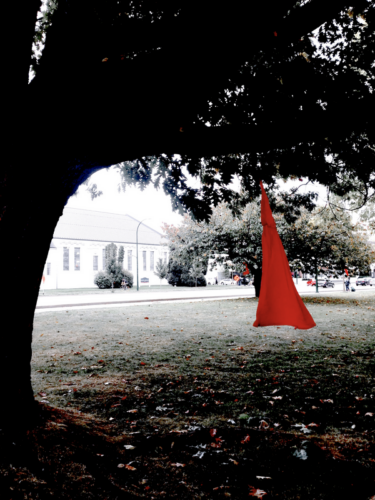Red Dress Day, also known as the National Day of Awareness for Missing and Murdered Indigenous Women and Girls and Two-Spirit People, is observed on May 5th.
The day honours and brings awareness to the thousands of Indigenous women, girls and two-spirit people who have been subject to disproportionate violence in Canada.
Red Dress Day was inspired by Méti artist Jaime Black’s REDress Project installation, in which she hung empty, red dresses to represent the missing and murdered women.
Red dresses have become symbolic of the crisis as a result of her installation.
***
The Indigenous Womens Council is organizing
an educational and solidarity event in Vancouver,
and everyone is invited to come out and show support.
Red Dress Event Details:
Where: Vancouver City Hall
When: Friday, May 5th at 12pm-2pm
Protocol: Be prepared to listen and learn
Additional information:
The event will include speakers, performers, a drum group, and food.
Mental health professionals will also be on site.
Be prepared for rain.
***
Missing and Murdered
Indigenous Women and Girls
and Two-Spirit People
Missing and Murdered Indigenous Women and Girls and Two-Spirit People (MMIWG2S) is a human rights crisis of gender-based and racialized violence in Canada.
The number of victims of the ongoing tragedy is contested. A 2014 Royal Canadian Mounted Police report identified 1,181 Indigenous women and girls who went missing or were murdered in Canada between 1980 and 2012. (See also Highway of Tears.)
However, Indigenous groups place this number at more than 4,000, citing underreporting and ineffective data keeping as reasons for the discrepancy. (See also Indigenous Women’s Issues in Canada.)
In Canada, Indigenous women, girls and members of the 2SLGBTQQIA (two-spirit, lesbian, gay, bisexual, trans, queer, questioning, intersex and asexual) community in Canada face disproportionate amounts of violence.
While Indigenous women account for less than 5 per cent of the Canadian population, they make up 24 per cent of female homicide victims.
https://www.thecanadianencyclopedia.ca/en/article/red-dress-day#
***
Running for Missing
and Murdered Indigenous Women
Rosalie Fish – TEDxYouth@Seattle
Rosalie Fish, 18, member of the Cowlitz Tribe, and a runner from the Muckleshoot Reservation in Auburn, Washington, uses her platform as a competitor to courageously raise awareness for missing and murdered indigenous women (MMIW).
***
The REDress Project

Missing and Murdered Indigenous Women and Girls
Art installation at Seaforth Peace Park in Vancouver, BC,
inspired by Métis artist Jaime Black’s REDress Project.
The red dresses symbolize the missing and murdered
Indigenous women and girls in Canada.
(courtesy Edna Winti/Flickr CC)
Métis artist Jaime Black began the REDress Project, an art installation, in 2010. Black gathered and hung hundreds of empty, red dresses to represent the missing and murdered Indigenous women and girls in Canada.
She described her artwork:
“Through the REDress Project, the spirits of the missing or murdered women and girls stand with us here today, giving us courage, strength and clarity — leading us forward on the path to REclaim our sovereignty as indigenous women.”
The first installation was at the University of Winnipeg in March 2011.
The project gained attention, and Black soon received hundreds of donated red dresses from across the country.
The REDress Project is now a permanent exhibit at the Canadian Museum for Human Rights and has been exhibited in Canadian universities, legislatures, hospitals and the Smithsonian’s National Museum of the American Indian.
Red dresses are also frequently hung outside, from trees, houses or statues, to bring awareness to the crisis.
Black was inspired to create the installation after hearing Métis writer and educator Jo-Ann Episkenew speak about the missing and murdered women and witnessing a group of women in Bogotá, Colombia wearing red dresses and raising awareness for missing family members.
Black also worked near the community of Indigenous murder victim Helen Betty Osborne. The idea of empty red dresses was inspired by the cover of The Book of Jessica: A Theatrical Transformation, co-authored by Linda Griffiths and Métis author Maria Campbell.
Red was chosen for the dresses because it is powerful and eye-catching, and represents both vitality and violence.
It was also chosen after Black learned from an Indigenous friend that red is the only colour that spirits can see, and which can be used to call the spirits of the lost back to reconnect with their loved ones.
The project contributed to the popularity of red as a symbol of the MMIWG2S movement.
***
Red Dress Day 2023: Liberal MP
Calls for Implementation of Alert System
Ahead of MMIWG2S
May 4, 2023
Speaking before question period in the House of Commons on Thursday, Liberal MP Jenica Atwin said that she was “devastated” that Indigenous women continue to be “senselessly” murdered and called for the implementation of a “red dress alert system” ahead of the National Missing and Murdered Indigenous Women, Girls and Two-Spirit (MMIWG2S) awareness day on May 5.
***
Red Dress Day
Inspired by Jaime Black’s REDress Project, Red Dress Day was first commemorated in 2010.
The day is used to pay respect to the victims, raise awareness of the crisis and call on governments to take action to address the racialized and gendered violence inflicted on Indigenous peoples in Canada.
Commemorations vary from community to community, but generally observers wear red and hang red dresses from trees, statues and doors.
In some communities, marches, processions and vigils are held. While Red Dress Day is not a statutory holiday, it has gained increasing recognition across the country.
In some provinces, October 4th is also recognized as a day to honour Missing and Murdered Indigenous Women and Girls.
Other commemorations include the February 14th Annual Women’s Memorial March, organized by women in the Downtown East Side neighbourhood in Vancouver.
The first march was organized in 1992 in response to the murder of an Indigenous woman in the city and has been held annually to honour the missing and murdered. It has expanded to cities across Canada and the United States.
https://www.thecanadianencyclopedia.ca/en/article/red-dress-day#

